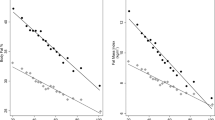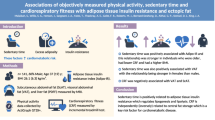Abstract
Background/Objectives:
The purpose of this study was to evaluate the independent and combined associations of moderate-to-vigorous physical activity (MVPA), leisure time sedentary behavior and daily protein consumption on lower extremity muscular strength and lean mass.
Subjects/Methods:
Data from the 1999–2002 NHANES were utilized (N=1080 adults 50–85 y). Leg lean mass was estimated from dual-energy x-ray absorptiometry scans. Knee extensor strength was assessed objectively using the Kin Com MP dynamometer. MVPA and leisure time sedentary behavior were assessed via questionnaire, with the number of meals per day of ⩾30 g of protein per meal assessed via a ‘multiple pass’ 24-h dietary interview.
Results:
Meeting MVPA guidelines (β=16.3, P=0.02) and consuming at least two meals per day of ⩾30 g of protein per meal (β=28.8, P=0.02) were independently associated with greater lower extremity strength, whereas sedentary behavior was not (β=11.6, P=0.23). Finally, there was no evidence of a three-way interaction of these behaviors on lower extremity strength (β=−8.7; P=0.70) or lower extremity lean mass (β=144.5; P=0.75).
Conclusions:
Although MVPA and frequency of protein consumption of ⩾30 g of protein per meal were independently associated with lower extremity lean mass and strength, the results of the present study do not provide evidence to suggest that there is a three-way interplay between MVPA, sedentary behavior and frequency of protein consumption ⩾30 g of protein per meal on lower extremity lean mass and strength.
This is a preview of subscription content, access via your institution
Access options
Subscribe to this journal
Receive 12 print issues and online access
$259.00 per year
only $21.58 per issue
Buy this article
- Purchase on Springer Link
- Instant access to full article PDF
Prices may be subject to local taxes which are calculated during checkout
Similar content being viewed by others
References
Shad BJ, Wallis G, van Loon LJ, Thompson JL . Exercise prescription for the older population: the interactions between physical activity, sedentary time, and adequate nutrition in maintaining musculoskeletal health. Maturitas 2016; 93: 78–82.
Bouchard C, Blair SN, Katzmarzyk PT . Less sitting, more physical activity, or higher fitness? Mayo Clin Proc 2015; 90: 1533–1540.
Loprinzi PD . Less sitting, more physical activity and higher cardiorespiratory fitness: associations with weight status. Mayo Clin Proc 2016; 91: 538–539.
Zampieri S, Pietrangelo L, Loefler S, Fruhmann H, Vogelauer M, Burggraf S et al. Lifelong physical exercise delays age-associated skeletal muscle decline. J Gerontol A Biol Sci Med Sci 2015; 70: 163–173.
Gianoudis J, Bailey CA, Daly RM . Associations between sedentary behaviour and body composition, muscle function and sarcopenia in community-dwelling older adults. Osteoporos Int 2015; 26: 571–579.
Gennuso KP, Thraen-Borowski KM, Gangnon RE, Colbert LH . Patterns of sedentary behavior and physical function in older adults. Aging Clin Exp Res 2016; 28: 943–950.
Breen L, Stokes KA, Churchward-Venne TA, Moore DR, Baker SK, Smith K et al. Two weeks of reduced activity decreases leg lean mass and induces ‘anabolic resistance’ of myofibrillar protein synthesis in healthy elderly. J Clin Endocrinol Metab 2013; 98: 2604–2612.
Churchward-Venne TA, Breen L, Phillips SM . Alterations in human muscle protein metabolism with aging: protein and exercise as countermeasures to offset sarcopenia. Biofactors 2014; 40: 199–205.
Morton RW, McGlory C, Phillips SM . Nutritional interventions to augment resistance training-induced skeletal muscle hypertrophy. Front Physiol 2015; 6: 245.
Loenneke JP, Loprinzi PD, Murphy CH, Phillips SM . Per meal dose and frequency of protein consumption is associated with lean mass and muscle performance. Clin Nutr 2016; 35: 1506–1511.
Chen L, Nelson DR, Zhao Y, Cui Z, Johnston JA . Relationship between muscle mass and muscle strength, and the impact of comorbidities: a population-based, cross-sectional study of older adults in the United States. BMC Geriatr 2013; 13: 74.
Statistics NCfH. Nutrition Examination Survey. Technical Documentation for the Dual Energy X-Ray Absorptiometry (DXA) Multiple Imputation Data Files. Centers for Disease Control and Prevention: Hyattsville, MD, USA, 2008.
Loprinzi PD, Kane CJ . Exercise and cognitive function: a randomized controlled trial examining acute exercise and free-living physical activity and sedentary effects. Mayo Clin Proc 2015; 90: 450–460.
Ainsworth BE, Haskell WL, Whitt MC, Irwin ML, Swartz AM, Strath SJ et al. Compendium of physical activities: an update of activity codes and MET intensities. Med Sci Sports Exerc 2000; 32 (9 Suppl), S498–S504.
Loprinzi PD . Lower extremity muscular strength, sedentary behavior, and mortality. Age (Dordr) 2016; 38: 32.
Keadle SK, Arem H, Moore SC, Sampson JN, Matthews CE . Impact of changes in television viewing time and physical activity on longevity: a prospective cohort study. Int J Behav Nutr Phys Act 2015; 12: 156.
McDowell MA, Hughes JP, Borrud LG . Health characteristics of US adults by body mass index category: results from NHANES 1999-2002. Public Health Rep 2006; 121: 67–73.
Mitchell JA, Bottai M, Park Y, Marshall SJ, Moore SC, Matthews CE . A prospective study of sedentary behavior and changes in the body mass index distribution. Med Sci Sports Exerc 2014; 46: 2244–2252.
Clark BK, Sugiyama T, Healy GN, Salmon J, Dunstan DW, Owen N . Validity and reliability of measures of television viewing time and other non-occupational sedentary behaviour of adults: a review. Obes Rev 2009; 10: 7–16.
Bartels R . Seemingly Unrelated Regressions. Wiley StatsRef: Statistics Reference Online, 2014. Available at: http://onlinelibrary.wiley.com/doi/10.1002/9781118445112.stat07758/abstract?userIsAuthenticated=false&deniedAccessCustomisedMessage=.
Mamerow MM, Mettler JA, English KL, Casperson SL, Arentson-Lantz E, Sheffield-Moore M et al. Dietary protein distribution positively influences 24-h muscle protein synthesis in healthy adults. J Nutr 2014; 144: 876–880.
Norton C, Toomey C, McCormack WG, Francis P, Saunders J, Kerin E et al. Protein supplementation at breakfast and lunch for 24 weeks beyond habitual intakes increases whole-body lean tissue mass in healthy older adults. J Nutr 2016; 146: 65–69.
Cermak NM, Res PT, de Groot LC, Saris WH, van Loon LJ . Protein supplementation augments the adaptive response of skeletal muscle to resistance-type exercise training: a meta-analysis. Am J Clin Nutr 2012; 96: 1454–1464.
Tieland M, Dirks ML, van der Zwaluw N, Verdijk LB, van de Rest O, de Groot LC et al. Protein supplementation increases muscle mass gain during prolonged resistance-type exercise training in frail elderly people: a randomized, double-blind, placebo-controlled trial. J Am Med Dir Assoc 2012; 13: 713–719.
Seymour JM, Spruit MA, Hopkinson NS, Natanek SA, Man WD, Jackson A et al. The prevalence of quadriceps weakness in COPD and the relationship with disease severity. Eur Respir J 2010; 36: 81–88.
Goodpaster BH, Carlson CL, Visser M, Kelley DE, Scherzinger A, Harris TB et al. Attenuation of skeletal muscle and strength in the elderly: the Health ABC Study. J Appl Physiol 2001; 90: 2157–2165.
Kwon HR, Han KA, Ku YH, Ahn HJ, Koo BK, Kim HC et al. The effects of resistance training on muscle and body fat mass and muscle strength in type 2 diabetic women. Korean Diabetes J 2010; 34: 101–110.
Churchward-Venne TA, Tieland M, Verdijk LB, Leenders M, Dirks ML, de Groot LC et al. There are no nonresponders to resistance-type exercise training in older men and women. J Am Med Dir Assoc 2015; 16: 400–411.
Phillips BE, Williams JP, Gustafsson T, Bouchard C, Rankinen T, Knudsen S et al. Molecular networks of human muscle adaptation to exercise and age. PLoS Genet 2013; 9: e1003389.
Buckner SL, Jessee MB, Mattocks KT, Mouser JG, Counts BR, Dankel SJ et al. Determining strength: a case for multiple methods of measurement. Sports Med 2016; 47: 193–195.
Seene T, Kaasik P . Muscle weakness in the elderly: role of sarcopenia, dynapenia, and possibilities for rehabilitaiton. Eur Rev Aging Phys Act 2012; 9: 102.
Bell KE, Seguin C, Parise G, Baker SK, Phillips SM . Day-to-day changes in muscle protein synthesis in recovery from resistance, aerobic, and high-intensity interval exercise in older men. J Gerontol A Biol Sci Med Sci 2015; 70: 1024–1029.
Fujita S, Rasmussen BB, Cadenas JG, Drummond MJ, Glynn EL, Sattler FR et al. Aerobic exercise overcomes the age-related insulin resistance of muscle protein metabolism by improving endothelial function and Akt/mammalian target of rapamycin signaling. Diabetes 2007; 56: 1615–1622.
Seene T, Kaasik P, Umnova M . Structural rearrangements in contractile apparatus and resulting skeletal muscle remodelling: effect of exercise training. J Sports Med Phys Fitness 2009; 49: 410–423.
Seene T, Alev K, Kaasik P, Pehme A . Changes in fast-twitch muscle oxidative capacity and myosin isoforms modulation during endurance training. J Sports Med Phys Fitness 2007; 47: 124–132.
Seene T, Kaasik P, Alev K . Muscle protein turnover in endurance training: a review. Int J Sports Med 2011; 32: 905–911.
Ferrando AA, Lane HW, Stuart CA, Davis-Street J, Wolfe RR . Prolonged bed rest decreases skeletal muscle and whole body protein synthesis. Am J Physiol 1996; 270 (4 Pt 1), E627–E633.
Itai Y, Kariya Y, Hoshino Y . Morphological changes in rat hindlimb muscle fibres during recovery from disuse atrophy. Acta Physiol Scand 2004; 181: 217–224.
Devries MC, Breen L, Von Allmen M, MacDonald MJ, Moore DR, Offord EA et al. Low-load resistance training during step-reduction attenuates declines in muscle mass and strength and enhances anabolic sensitivity in older men. Physiol Rep 2015; 3: e12493.
Loprinzi PD, Loenneke JP, Ahmed HM, Blaha MJ . Joint effects of objectively-measured sedentary time and physical activity on all-cause mortality. Prev Med 2016; 90: 47–51.
Tooze JA, Troiano RP, Carroll RJ, Moshfegh AJ, Freedman LS . A measurement error model for physical activity level as measured by a questionnaire with application to the 1999-2006 NHANES questionnaire. Am J Epidemiol 2013; 177: 1199–1208.
Acknowledgements
Author contributions
PDL conceived the study, computed the analyses and wrote the manuscript. JPL and DLH interpreted the results and wrote the manuscript.
Author information
Authors and Affiliations
Corresponding author
Ethics declarations
Competing interests
The authors declare no conflict of interest.
Rights and permissions
About this article
Cite this article
Loprinzi, P., Loenneke, J. & Hamilton, D. Leisure time sedentary behavior, physical activity and frequency of protein consumption on lower extremity strength and lean mass. Eur J Clin Nutr 71, 1399–1404 (2017). https://doi.org/10.1038/ejcn.2017.101
Received:
Revised:
Accepted:
Published:
Issue Date:
DOI: https://doi.org/10.1038/ejcn.2017.101
This article is cited by
-
Protein Requirements for Master Athletes: Just Older Versions of Their Younger Selves
Sports Medicine (2021)
-
Daily lifestyle behaviors and risks of sarcopenia among older adults
Archives of Public Health (2020)



